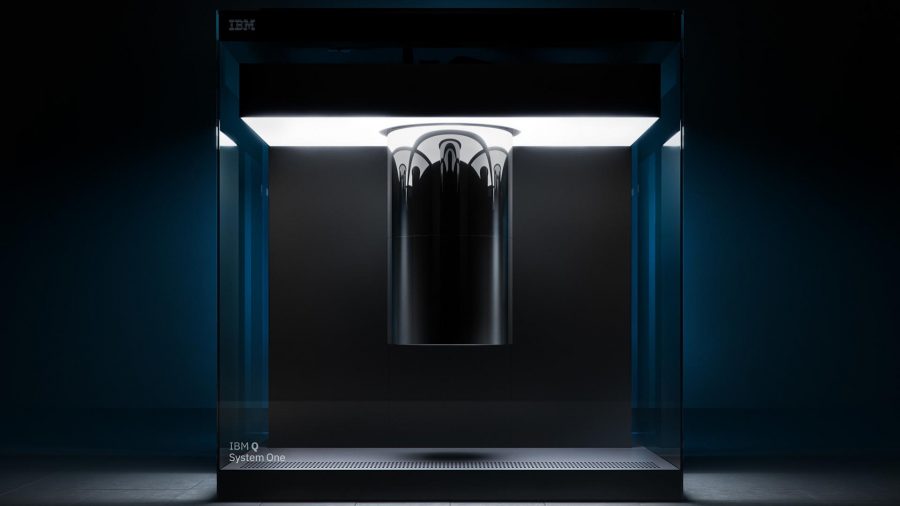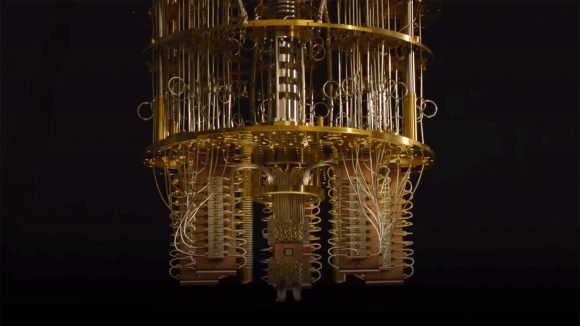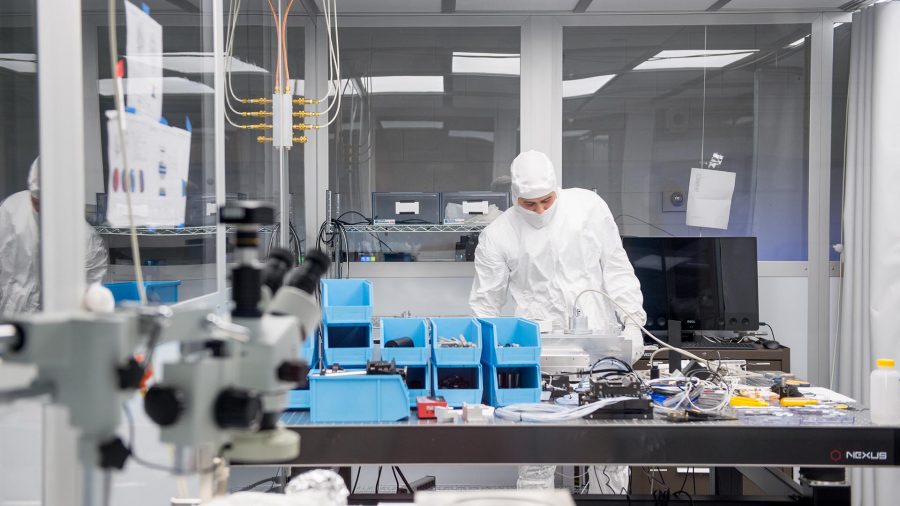Quantum computing is the next generational shift in technology, and is quickly shifting from purely theoretical thought experiments in the labs to practical, commercially available quantum processors. In the cloud at least. And inside those chips reside the all-important qubits: particles that could change the way we compute on a grand scale.
While we’re not quite at the ‘quantum supremacy’ tipping point just yet, universities, researchers, and Silicon Valley companies are all entangled in quantum fever. But just how close are we to that quantum computing inflection point and who are the boffins trying to get us there?
Using Quantum bits, or qubits, these complex computers exist outside the binary 1s and 0s world of technology we know today. The parallel, interconnected power of qubits could one day revolutionise pharmaceutical research, material and chemical modelling, AI, cryptography, financial systems, and help humankind explore and understand the universe.
“Can a quantum system be simulated by a classical universal computer? In other words, a computer which will give the same probabilities as the quantum system does,” Richard Feynman, world-renowned theoretical physicist, quantum computing pioneer, and developer of the atomic bomb said at Caltech in 1982 (Int. Journal of Theoretical Phys., Vol. 21, 1982).
“If you take the computer to be the classical kind I’ve described so far, and there are no changes in any laws, and there’s no hocus-pocus, the answer is certainly, No!
“…our only hope is that we’re going to simulate probabilities, that we’re going to have our computer do things with the same probability as we observe in nature, as calculated by the quantum mechanical system.”
Feynman’s words equate to a firing of the starting pistol in the quantum computing race towards a machine that mimics the very universe we live in – a quantum computer. Qubits can exist in a superposition, that is: 1, 0, or some combination of both simultaneously. Qubits are also linked; bonded together by entanglement. This unique property, without equal in the classical computing world, produces correlated quantum states between two otherwise separate qubits.
And that all has the potential for mammoth, albeit currently exceptionally fragile, processing power. But quantum also requires pristine, exam-hall grade, conditions to produce accurate results. This is often achieved through the use of dilution refrigerators; chillers capable of keeping temperatures to ever-so-slightly above absolute zero – colder than even deep space. The size and effectiveness of these refrigeration units is one limiting factor in scaling up quantum computers enough to break into supremacy.
Even with necessary precautions in place, noise on a particle level can ‘decohere’ qubits, leading to unexpected results and potentially propagated exponentially across millions of individual calculations. Errors are inherent to many quantum systems today, and constant error correction and qubit over-provisioning is critical to making the quantum dream a reality.
Yet no two ways of harnessing quantum particles are the same, and humankind (that’s me tacitly taking credit for the work of a few very smart people) is hard at work creating a machine to acquiesce to Feynman’s request and reach quantum supremacy.
Often independently from, but occasionally in tandem with, the companies listed below, there are a number of teams or individual academics hard at work to take theory into practice, too.
Quantum computing is still in its embryonic stages, error-correcting quickly ramps up the qubits necessary for that watershed moment. But with so much power on the line, and huge commercial viability, there’s already massive interest in the research and development of these groundbreaking machines. These are the companies hard at work to get us over the line.
Google proposed back in 2017 that it would realise short-term commercial benefits with quantum computing in the next five years. That paper was published in Nature, vol.543, 2017, so we’re into year two of Google’s commercial quantum dream already.
The most notable addition to Google’s quantum family since has been Bristlecone: a 72 qubit gate-based superconducting chip produced by Google’s AI Quantum lab, and featuring a two-qubit gate error < 0.5%. Google is “cautiously optimistic” it can create a supremely quantum machine with this chip, and it hopes to keep pushing Bristlecone until it’s down to 0.1% – parity with its previous nine-qubit chip.
From here on out, Bristlecone will act as proof-of-concept for the search engine giant, with future hardware, algorithms, and software all set to rely on the principles henceforth laid out by the chip.
But that’s not the only project in the entangled pipeline. At the 2019 International Solid State Circuits Conference in San Fran, the AI Quantum team also unveiled a cryogenic controller built on CMOS technology. This temperature resistant unit allows Google’s quantum researchers to manipulate and measure qubits from within the controlled, -400 degree fahrenheit quantum enclosures. Just one of many innovations required for truly scalable quantum computers.
Intel
Let’s talk lakes. No, not Skylake or one of its many iterations, this is something truly different from Chipzilla. Tangle Lake is the result of Intel’s efforts in the quantum computing field, a journey from 7 to 17 and now up to 49-qubits. Intel has been corroborating with QuTech in the Netherlands in its quest to deliver a commercially viable quantum system.
The superconducting Tangle Lake test chip was unveiled back at CES 2018, a 3-inch by 3-inch chip featuring 108 gold radio frequency connectors to carry microwave signals from each of its 49 qubits. Each quantum bit is moulded from niobium: the 34th-most common element in the Earth’s crust.
According to Intel Labs VP Mike Mayberry, the Tangle Lake chip is still a few hundred thousand qubits short of a commercially relevant chip, however.
“We expect it will be five to seven years before the industry gets to tackle engineering-scale problems, and it will likely require one million or more qubits to achieve commercial relevance,” Mayberry says.
But Intel is also looking into spin qubits – an alternative approach that could eventually offer manufacturing access on a mass scale. Spin qubits are far smaller than their superconducting counterparts, and, conveniently, have potential to be implemented in silicon on existing semiconductor manufacturing techniques.
Microsoft
Microsoft is reaching out for a piece of the quantum pie – for the record it’s both apple and cherry at the same time (thanks, Dad). The tech company can enter the quantum race from a rather advantageous position, too, afforded to it from its standing as the world’s largest company.
Its mission is to create “the world’s first truly scalable quantum computer”. And Microsoft is pretty confident its qubits are the best, and far less prone to errors than those of its competitors.
That’s because it is building a topological quantum PC – one which harnesses the branch of mathematics dedicated to bending, twisting, compacting, and stretching. This topological quantum machine utilises electron fractionalization and ground state degeneracy – essentially splitting an electron in half and utilising two ground states – to add extra redundancy to a qubit’s state, thus making it less vulnerable to interference or quantum noise.
With fewer errors, and less need for error-correcting provisions, Microsoft believes it can scale beyond its competitors without instigating problems in room-scale refrigeration or measurement.
“If topological qubits were used in the example of nitrogenase simulation, the required 200 logical qubits would be built out of thousands of physical qubits,” Microsoft says. “However, if more traditional types of qubits were used, tens or even hundreds of thousands of physical qubits would be needed to achieve 200 logical qubits. The topological qubit’s improved performance causes this dramatic difference; fewer physical qubits are needed to achieve the logical qubits required.”
With a view to commercialise its product, Microsoft has released the Microsoft Quantum Development Kit: a set of libraries and necessary tools required to code in its quantum-focused programming language Q#. And once you’ve scaled past local solutions, Microsoft is planning to embrace the quantum space with its Azure infrastructure up in the cloud.
IBM
If it’s a commercially viable quantum computing product you’re after, IBM will have its foot in the door from day one. IBM currently has a quantum fleet comprised of five 20-qubit systems, one 14-qubit system, and four 5-qubit systems. IBM has also announced that it will soon launch a 53-qubit quantum computer, the single largest universal quantum system available for external access.
Earlier in the year, IBM announced the world’s first commercially available integrated quantum computer: the Q System One. The Q System One is available to researchers and businesses alike via the cloud. While the superconducting machine itself lives in a 9x9ft protective enclosure behind borosilicate glass originally intended to keep the crown jewels and the Mona Lisa safe.
It’s certainly a work of art in its own right. From the cryogenic exterior to its golden quantum core, the Q System One is a thing of genuine beauty. IBM developed the system to be “sophisticated, modular, and compact.”
And that quantum core? IBM breaks down exactly what goes into that, too. Each tier colder than the last.
- At the tip of this superconducting stalactite is the cryoperm shield kept to 15 millikelvins. Hidden within is the quantum processor itself, protected from electromagnetic radiation.
- Next to that are the quantum amplifiers. These amplify readout signals from the chip itself, but do so without injecting too much noise into the system.
- Above all that, at the 100 millikelvin level, there’s the mixing chamber. This is the last stop of the refrigeration unit before the chip. It’s the equipment capable of dropping temperatures down to 15 mK.
- Next to that, the cryogenic isolators – similarly repeating the quantum signals while minimising noise.
- Then the superconducting coaxial lines. These direct signals between the first and second amplifying stages.
- Right at the top, somewhere between 4 kelvin and 800 millikelvin, there’s the input microwave lines. Each step measures are carried out to keep thermal noise from reaching the precious quantum bits.
- And last but not least, the Qubit signal amplifier: the secondary signal amplifier.
But there’s more to IBM’s quantum game. Its systems leverage Qiskit, an open-source quantum computing framework creating a quantum environment accessible to researchers and students alike access and create quantum programs without requiring an in-depth knowledge of all the specifics. And there’s also the IBM Q Experience: a virtual interface for coding in quantum.
The best bit? You can already access IBM’s 5- and 16-qubit quantum computers through the IBM Q Experience and Qiskit.
D-Wave
D-Wave is best known for the D-Wave 2000Q: “the most advanced quantum computer in the world.” This superconducting machine is a momentous feat in its own right, yet the company broke into “world first” territory with the Leap platform: the first real-time quantum application environment.
But D-Wave isn’t without its sceptics. The company’s high-qubit-count machines’ quantum properties have been called into question by academics worldwide. They claim that the process known as ‘quantum annealing’ isn’t truly quantum at all, and will never surpass conventional computing in brute number-crunching power.
Yet Google and NASA are among its proponents. After successfully passing the companies’ quantum benchmarks, they opted for D-Wave systems to discover quantum’s potential in creating artificial intelligence.
The company recently announced the Pegasus topology, a new quantum computing platform expected to hit the market mid-2020. Complete with 5,000 qubits, D-Wave claims it to be the most connected of any system worldwide.
Each qubit will connect with 15 others, an improvement on the six qubit connectivity of its current 2000-qubit topology.
“With the next-generation platform we are making investments in things like connectivity and hybrid software and tools to allow customers to solve even more complex problems at greater scale,” says D-Wave CPO, Alan Baratz, “bringing new emerging quantum applications to life.”

Image from Rigetti
Rigetti
Rigetti is a start-up managing, rather miraculously, to keep pace in the quantum arms race against the largest tech titans in the world. Even its $119 million from investors is a drop in the ocean compared to the bankroll of Microsoft, Google, and IBM. But, nevertheless, it has plenty of skin in the quantum game.
Rigetti has three quantum processors:
- 16Q Aspen-1: Asymmetric transmon qubit-based system
- 8Q Agave: Eight physical superconducting qubit system
- 19Q Acorn: 20 physical qubit system
QCS, or the Quantum Cloud Services, is Rigetti’s quantum-first cloud platform, blending classical and quantum computing power into one environment.
But Rigetti’s head of quantum technology, Blake Johnson, has cited issues getting his hands on the necessary components to create quantum computers.
All those refrigerators require helium-3, a by-product of nuclear missile stockpiles. Now that the doomsday clock has been, thankfully, ever-so-slightly reversed, and many a bilateral arms reduction treaty has been signed, nuclear arsenals are being depleted. That means there’s a lot less of this precious gas than ever before.
Microwave transmitting cables are also hard to come by, and renewed efforts are required to convince suppliers to look for new markets in quantum computing research.
IonQ
Maryland-based quantum company IonQ was founded in 2016 by physicist Chris Monroe and Jungsang Kim. Its goal: take trapped ion quantum computing out of the lab and into the market.
Since then it’s rustled up $20 million in funding and managed to put together two rather unusual quantum computers. Whereas most quantum chips rely on superconducting electronics kept suitably chilled in dilution refrigerators, IonQ utilises ytterbium ions trapped with electromagnetic fields within a vacuum chamber for its two machines. An approach called ion trapping.
Each isolated atom is subsequently operated on through the use of precise lasers, which also serve to entangle arbitrary pairs of qubits where other quantum approaches could not.
And the resulting ion trap quantum processor is far more robust than rival machines, able to “handle longer calculations than other quantum computers” before its qubits go up in smoke. IonQ maintains its entangled machine is capable of single and double qubit gate fidelity (a measure of logical operation accuracy) of 99.7% and 99.3%, respectively.
“Atomic qubits are perfect, so we don’t need to spend any more time on the physics. Our work is now focused on systems engineering and integration,” Jungsang Kim, co-founder of IonQ and engineering professor at Duke, says. “Every quarter we make our lasers more precise and our ion trap package more capable through the increased sophistication of our control software. Each improvement dramatically expands our processing power.”
With a view to taking ion trap qubits commercial in 2019, IonQ’s relative atomic precision could have massive potential in the race towards quantum supremacy.
And before you say: ‘why should a gamer give a damn about quantum?’, imma let you finish, but IBM quantum computing physicist James Wootton, participating in the Quantum Game Jam, has already developed a game of Battleships for entangled machines.
The uncertain nature of quantum was even incorporated into the game itself. Errors in the output – quantum noise interfering with the results – are accepted to be random acts of nature or chance, a lightning strike or tsunami.
And while using a quantum machine for gaming is drastically underselling its full potential, there are heaps of developers using game development as a tool to teach, learn, and solve problems in the quantum space.
But don’t expect a quantum Playstation in the near-future… or maybe ever for that matter. Quantum computing still has a long way to go to prove itself more than a fad, or offer convincing results beyond that which a classical computer could. Moore’s Law isn’t dead yet, classical tech is similarly developing at a rapid pace… and at least we know that stuff works.







